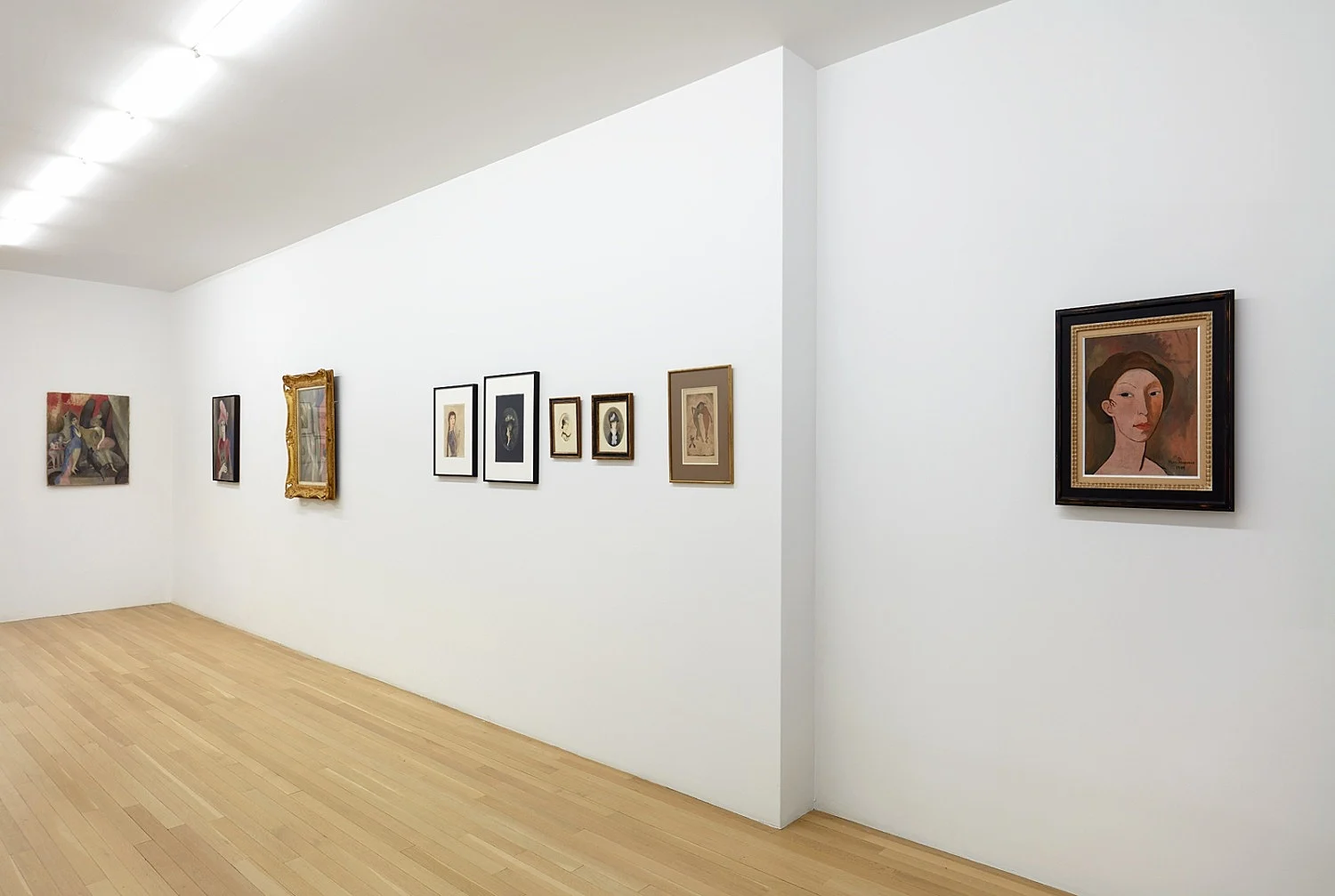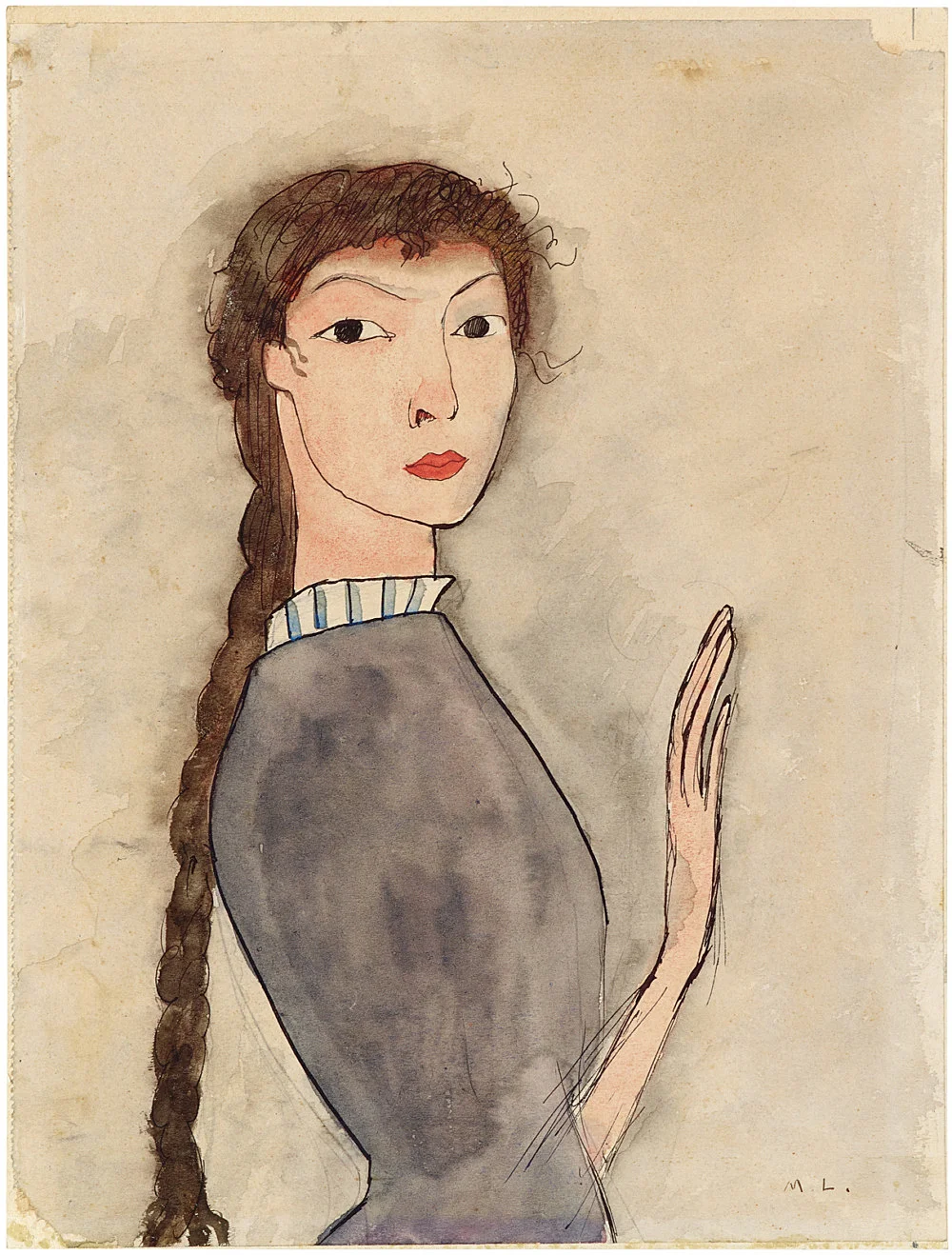

an exhibition organized
by Jelena Kristic
23 May 2020
opening on Thursday, 5 March,
6-8 pm
Marie Laurencin
an exhibition organized by Jelena Kristic
5 March - 23 May 2020
opening reception on Thursday, 5 March, 6-8 pm
Everybody called Gertrude Stein Gertrude, or at most Mademoiselle Gertrude, everybody called Picasso Pablo and Fernande Fernande and everybody called Guillaume Apollinaire Guillaume and Max Jacob Max but everybody called Marie Laurencin Marie Laurencin. (1)
Galerie Buchholz is pleased to present the first exhibition devoted to the work of Marie Laurencin (1883-1956) in the United States since 1989 and the first in New York since 1956.
Surveying a slice of her prolific output of paintings, watercolors, drawings, prints, and book illustrations, dating from 1904 until 1953, the exhibition examines Laurencin’s double strategy to disseminate her work as a consumable surrogate for herself and, at the same time, to generate a space of self-determination within received ideas about femininity and female painting.
As a popular society portraitist who also collaborated with leading members of the avant-garde, Laurencin generated ambiguous distances between her artistic identity and her work, and between what is represented and how this was received. These distances conferred on her a power to frame the conditions of her work’s visibility - something that she staged with the motif, for example, of the curtain. It is precisely by operating from a chameleon-like position marked by deferral and remove that Laurencin is able to create an unsettled foil to masculine modernism. As she writes in her autofictional memoir, “If I feel far away from painters it is because they are men - and men seem to me to be difficult problems to solve. Their discussions, their research, their genius, have always surprised me and without them nothing would exist; living in their shadow is possible, when one doesn’t intend to imitate them.” (2)
After training as a commercial porcelain painter, Laurencin later attended the Académie Humbert, where she studied painting and met Georges Braque, who became a supporter of her work and introduced her to the “Bateau-Lavoir” group, and Francis Picabia, with whom she would collaborate on the first four issues of 391 while they were both living in Barcelona during World War I. She was included the 1911 Salon des Indépendents as well as the 1912 “Maison Cubiste” exhibition of the Salon d’Automne. Her New York debut occurred on the occasion of the 1913 Armory Show. Laurencin was represented by major modern art dealers throughout her lifetime, first by Wilhelm Uhde and Marius de Zayas and later by Paul Rosenberg and Pierre Matisse. Alongside her painting practice, Laurencin executed commissions for private residences (such as decorative architectural panels) and businesses (such as Helena Rubinstein’s beauty parlors), and designed costumes and sets for the theatre (such as the Ballets Russes production of Les Biches).
Her early work, represented by Autoportrait (Self-portrait) (1908), Le Pont de Passy (The Passy Bridge) (1912) and La maison meublée (1912), features graphic lines and flattened figures, rendered in an intentionally naïve, Sunday painter style. Here she begins her inquiry into the stereotypes associated with female painting as both a critical reflection of them and a marketing operation promoting her work. That Laurencin chose the arched river bridge, a token motif of fables and European urban architecture, as a repeated motif in her works echoes the “in between” social and critical positioning she both received and actively cultivated. Her work, and her identity as an artist, was neither here nor there, neither decorative nor avant-garde, “between Picasso and Rousseau,” “between the Fauvists and the Cubists, caught in a trap, the little doe.” The bridge repeatedly recurs as nondescript architecture in the fable-like settings of Diane (1921) and Fête champêtre (1928), and in late works such as Trois jeunes femmes (Three Young Women) (1953).
The repetition and reproduction of the homogenous “look” of her subjects and color palette are other formal devices that function as destabilizing distancing strategies. In Deux amies (Two Friends) (1928), two very similar-looking women stand close together next to a canvas. The existence of the canvas vaguely suggests an artist-model relationship, confusing a clear reading of the identity of the subjects. The doubling of the women echoes the generalized repetition in Laurencin’s practice, the reproduction of artist and subject, and one painting’s relationship to every other painting. Undifferentiated likeness proliferates and reflects, and identity is divorced from expected resemblance. In fact, the distance between Laurencin’s portrait resemblance to its physical subject, and its likeness to her paintings of anonymous young women, caused a few of Laurencin’s sitters to reject their commissioned portraits, most famously Coco Chanel and Lady Cunard.
Laurencin’s idiosyncratic program of uniformity is also enacted on the level of subject matter. Storybook characters - the goddess Diana, Queen Marie de’ Medici, the Princess of Clèves - fungibly interchange with self-portraits, commissioned portraits, and portraits of Suzanne Moreau, Laurencin’s housekeeper. This interchange is embodied clearly in La femme-cheval (The Woman-Horse) (1918), her self-portrait as a mutant femme peintre, a hybrid creature of her own making, fit to corral her progeny. Laurencin’s work in print, book illustration, decorative arts, and theater design further supports her strategy of omnivorous proliferation, reproducing “the young woman” in different scales and contexts, and thus complicating the distinctions between innovation and cliché, painting and female painting.
The exhibition features a number of important loans from the Fondation Musée Marie Laurencin in Tokyo, Japan, for which the gallery and curator express great gratitude. Marie Laurencin’s last solo exhibition in the United States took place at the Birmingham Museum of Art, Alabama, in 1989 and in New York at Paul Rosenberg & Co. in 1956. Since then, significant institutional exhibitions on Laurencin’s work have taken place at the Musée Marmottan Monet, Paris, France (2013), Musée Marie Laurencin, Nagano, Japan (2003), and the Fondation Pierre Giannada, Martigny, Switzerland (1993-94).
A catalogue for this exhibition is forthcoming.
(1) Gertrude Stein, The Autobiography of Alice B. Toklas, London, Penguin Classics (2001) p. 68.
(2) Marie Laurencin, Le Carnet des nuits, Brussels, Editions de la Nouvelle Revue Belgique (1942), p. 47-48.



Marie Laurencin
“Auto-portrait (Self-portrait)”, 1908
oil on canvas
41.4 x 33.4 cm
Musée Marie Laurencin, Tokyo

Marie Laurencin
“Chanson de Bilitis (Song of Bilitis)”, 1904
etching and aquatint
24 x 15 cm
Private collection

Marie Laurencin
“Portrait de femme (Portrait of a Woman)”, 1905
gouache and pencil on paper
16 x 15 cm (oval)

Marie Laurencin
“Autoportrait au chien (Self-portrait with a Dog)”, 1919-1920
pencil and crayon on paper
20.5 x 15.5 cm (oval)

Marie Laurencin
“La Femme-cheval (The Woman-Horse)”, 1918
oil on canvas
61.8 x 46.8 cm
Musée Marie Laurencin, Tokyo

Marie Laurencin
“Femme au chien (portrait) (Woman with a Dog (portrait))”, 1924
oil on canvas
65 x 50 cm

Marie Laurencin
“La maison meublée”, 1912
oil on canvas
112 x 144 cm
Musée Marie Laurencin, Tokyo
installation view Galerie Buchholz, New York 2020

Marie Laurencin
“Le Pont de Passy (The Passy Bridge)”, 1912
oil on canvas
50 x 74.3 cm
Musée Marie Laurencin, Tokyo
installation view Galerie Buchholz, New York 2020

Marie Laurencin
“Le Pont de Passy (The Passy Bridge)”, 1912
oil on canvas
50 x 74.3 cm
Musée Marie Laurencin, Tokyo

Marie Laurencin
“L’Abbesse d’Æéa“, 1921
suite of 10 prints for “Éventail”
10 etchings
each 19 x 11 cm
installation view Galerie Buchholz, New York 2020

Marie Laurencin
“L’Abbesse d’Æéa“, 1921
Illustration for “The Abbess of Æéa” by Roger Allard, from the suite of 10 prints for “Éventail”
etching
19 x 11 cm

Marie Laurencin
“L’an Suave”, 1921
Illustration for “The Sweet Year” by André Breton, from the suite of 10 prints for “Éventail”
etching
19 x 11 cm

Marie Laurencin
“Le Miroir”, 1921
Illustration for “The Mirror” by Francis Carco, from the suite of 10 prints for “Éventail”
etching
19 x 11 cm

Marie Laurencin
“La Nymph d’Auteuil”, 1921
Illustration for “The Nymph from Auteuil” by Loris Codet, from the suite of 10 prints for “Éventail”
etching
19 x 11 cm

Marie Laurencin
“Prose pour Pallas ambiguë”, 1921
Illustration for “Prose for Ambiguous Pallas” by Fernand Fleuret, from the suite of 10 prints for “Éventail”
etching
19 x 11 cm

Marie Laurencin
“Qui n’entend qu’une cloche”, 1921
Illustration for “Who only hears a bell” by Georges Gabory, from the suite of 10 prints for “Éventail”
etching
19 x 11 cm

Marie Laurencin
“Olga”, 1921
Illustration for “Olga, a short story” by Max Jacob, from the suite of 10 prints for “Éventail”
etching
19 x 11 cm

Marie Laurencin
“La rue Soufflot”, 1921
Illustration for “La rue Soufflot, a Romance” by Valery Larbaud, from the suite of 10 prints for “Éventail”
etching
19 x 11 cm

Marie Laurencin
“Fil de rêve”, 1921
Illustration for “Thread of Dreams” by Jean Pellerin, from the suite of 10 prints for “Éventail”
etching
19 x 11 cm

Marie Laurencin
“Elégie fraternelle”, 1921
Illustration for “Fraternal Elegy” by André Salmon, from the suite of 10 prints for “Éventail”
etching
19 x 11 cm

Marie Laurencin
“Fête champêtre”, 1928
watercolor on paper
28 x 72.6 cm
Musée Marie Laurencin, Tokyo

Marie Laurencin
“Deux jeunes femmes au chien en forêt (Two Young Women with a Dog in the Forest)”, ca. 1925-1926
oil on canvas
46 x 38 cm
Collection of Matthew Marks and Jack Bankowsky

Marie Laurencin
“Deux amies (Two Friends)”, c. 1928
oil on canvas
55.2 x 46.5 cm
Musée Marie Laurencin, Tokyo

Marie Laurencin
“Autoportrait aux perles en bleu (Self-portrait with Pearls in Blue)”, 1930
oil on canvas
35 x 27 cm

Marie Laurencin
“La fillette aux rubans dans les cheveux (The Little Girl with Ribbons in Her Hair)”, n.d.
oil on canvas
33 x 24 cm

Marie Laurencin
“Fillette coiffée de fleurs (Little Girl Wearing Flowers)”, 1926
oil on canvas
41 x 33 cm
Collection of Richard Burkland

Marie Laurencin
“Trois jeunes femmes (Three Young Women)”, c. 1953
oil on canvas
97.3 x 130.3 cm
Musée Marie Laurencin, Tokyo

Marie Laurencin
“Suzanne Moreau (en bleu) (Suzanne Moreau (in blue))”, 1940
oil on canvas
65 x 54.2 cm
Musée Marie Laurencin, Tokyo

Marie Laurencin
“La petite loge ou Au theatre (The Small Loge or At the Theater)”, 1925
etching
17 x 11 cm
Private collection

Marie Laurencin
“La petite loge ou Au theatre (The Small Loge or At the Theater)”, 1925
etching
17 x 11 cm
Private collection

Marie Laurencin
“Les trois jeunes filles jouent à l’arc (Three Young Girls Playing with a Bow and Arrow)”, 1926
etching with hand coloring
13 x 8 cm
Private collection

Marie Laurencin
“Huit filles dans un pré (Eight Girls in a Field)”, 1926
frontpiece for “Huit filles dans un pré” by Jean Richard Bloch
etching
18 x 13 cm

Marie Laurencin
“Le chapeau sur les yeux (The Hat Over the Eyes)”, 1923
etching and watercolor on paper
8.5 x 7 cm

Marie Laurencin
“Portrait de l’Artiste (Portrait of the Artist)”, 1927
lithograph on imitation Japanese paper
37 x 27.5 cm

Marie Laurencin
“Jeune fille à la guitare (Young Woman with Guitar)”, 1946
etching and drypoint with hand-coloring
20 x 17 cm

Marie Laurencin
“Monsieur de Nemours and Madame de Clèves”, 1947
lithograph
Illustration from “La Princesse de Clèves” by Robert Laffont
18.7 x 12 cm
Private collection

Marie Laurencin
“Le Barque ou L’Assemblé (The Rowboat or The Assembly)”, 1926
etching
30 x 36 cm
Private collection

Marie Laurencin
“Untitled [Flowers]”, 1928
From “L’Adroite Princesse ou Les Adventures de Finette” by Marie-Jeanne L’Héritier de Villandon
lithograph
46 x 37 cm
Courtesy Galerie Buchholz





































































































































